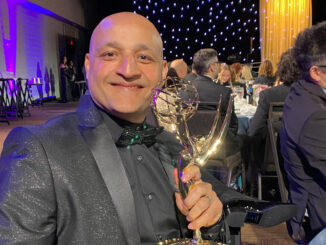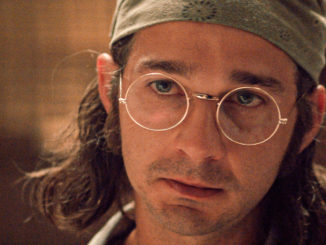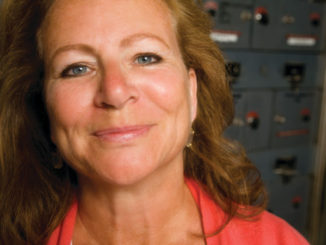
By Rob Feld
When it comes to crafting the deeply personal world of Netflix’s comedy “Mo,” editors Andrea Folprecht, ACE and Lauren Connelly, ACE have been instrumental in shaping the show’s distinct rhythm and tone.
Folprecht, who has been with the series since its 2022 debut, first connected with the project through director Solvan “Slick” Naim after their collaboration on “BMF.” “We just sort of gelled,” she said. “So, when he told me about this comedy for Netflix, I was immediately interested.”
Connelly joined in Season 2, coming to the show through a different path—a general meeting at A24 eventually led to an interview, and then a call for the job. “Andrea was so welcoming and collaborative,” Connelly said. “It was great to walk into a warm environment and be part of a team right away.”
Their work has been pivotal in navigating the series’ unique balance of humor, heart, and social commentary. Season 2 finds Mo Najjar, the Palestinian refugee of the title, stranded in Mexico, racing against time to return home before his family’s crucial asylum hearing. Without a passport and as a stateless refugee, getting back to Houston is just the beginning of his struggles. Blending comedy and deep emotion, Folprecht and Connelly’s combined expertise conspire to bring an editing approach that weaves together multiple cultures, languages, and tones, to bring Mo’s personal journey to life.
CineMontage: Tell me about the workflow on this series. You have a creator who is also a writer, director, and star.
Andrea Folprecht: The production block-shoots all eight episodes of a season at once. I make a calendar for myself to track when I’m getting dailies and how many, just to help my brain figure out when to start. When you only have a couple of scenes from an episode, there’s not much you can do yet. You really have to wait until you have enough before diving into a music or a sound effects pass. That makes this a challenge. It helps that I’ve got a great AE, Peter McCann, to help collaborate and strategize getting all the finishing touches into an episode. And since Mo and Slick are on set, we don’t really get them until production wraps—then we get them 110 percent.
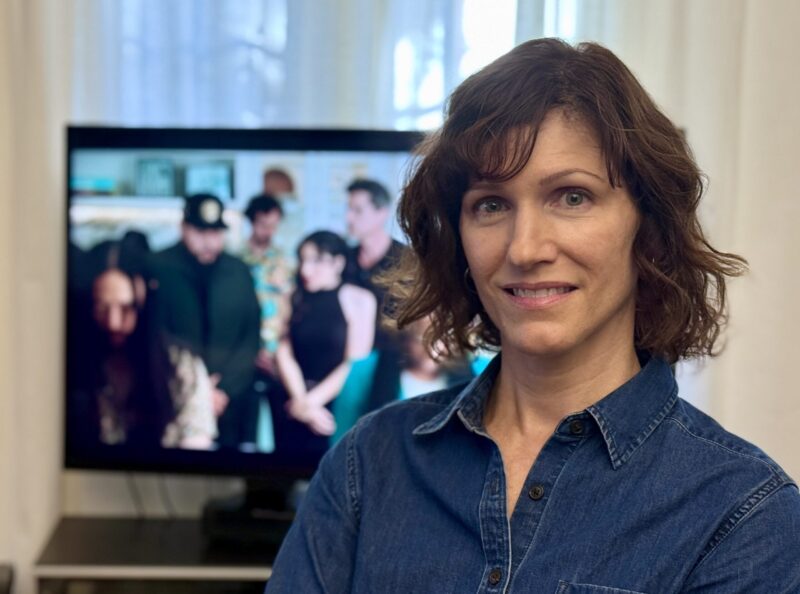
CineMontage: Tell me about that 110 percent. How are you working together?
Lauren Connelly: Working with Mo Amer & Solvan “Slick” Naim was such a wonderful experience because they are so collaborative and just a lot of fun to work with. We did the show fully remote, so we spent a lot of time on Evercast. We each had our own room, and Mo would pop back and forth. Slick came in first for his episodes’ director days with each of us, and then Mo took over as showrunner.
Folprecht: In Season 1, Slick directed every episode, but in Season 2, Mo directed three. So, depending on the episode, Mo was both director and producer, handling notes from all directions. He’s very detail-oriented—all the way down to music and finishing touches—so he’s in there with us a lot.
CineMontage: What have you found defines the voice of this show? How do the edit choices on “Mo” differ from other projects you’ve worked on?
Connelly: Honestly, my approach to cutting stays the same across all projects and genres. Early in my career, editor Peter Teschner gave me great advice: Never be pigeonholed. I took that to heart, seeking out projects across a wide range of genres and tones. No matter what, it always comes down to character, emotion, and staying true to the story. The funniest comedies can still touch your heart, and the saddest dramas can have humor in their darkest moments. That mindset was really valuable on “Mo” because you’re dealing with serious subject matter within a 30-minute comedy. Staying open-minded, collaborating, and being willing to experiment was key to managing the tone.
Folprecht: Yeah, I totally agree. For “Mo” specifically, I know they want a tight pace. Both Slick and Mo like things dynamic and fast, so I shape the edit that way from the start. I don’t believe in leaving fat in a cut, but that’s true for most shows I work on. And then, of course, there’s the comedy element. I only keep the jokes that really land or are necessary to move the story forward. Sometimes I’ll leave in extra humor, knowing we’ll trim it down later. Other times, I’ll get notes saying, “We need another joke here”—or the opposite: “Too many jokes, let’s pull one out.” That’s a pretty common process in comedy.
CineMontage: Do you get a ton of coverage, or is the approach more structured?
Connelly: There’s definitely a lot of coverage. With a stand-up comic at the helm, it won’t surprise anyone to hear that they do a lot of improv and script experimentation. Slick also likes to try different things, and if something isn’t working, they’ll pivot—often without cutting the camera. So, we end up with long takes, lots of resets, and plenty of different variations. One scene in the finale was about a minute and a half long, but I got hours of footage for it—just tons of different jokes in series, back-and-forths, and alternate reads. That was on the extreme end, but it gives you an idea!
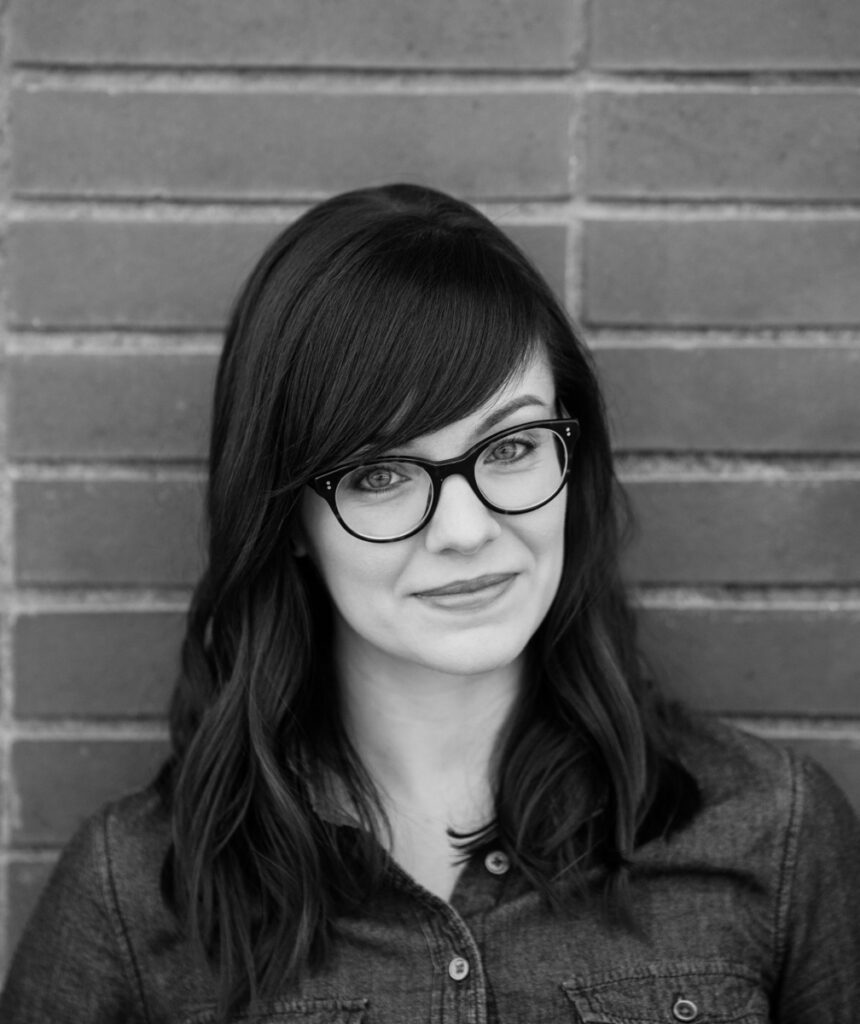
CineMontage: Are they giving you a lot of inserts and close-ups, or do you lean into two-shots since comedy often plays in wider frames?
Connelly: For me, I usually don’t cut based on size—I let the footage speak to me. I’ve built entire scenes around a single moment, whether it made me laugh out loud or genuinely moved me. That becomes the anchor, and I structure the scene around it. There’s traditional film language most shows follow, but I don’t believe in rigid rules. I think it’s important to stay open-minded. When watching dailies, I trust my gut and build from what feels right.
Folprecht: Absolutely. In general, they shoot a lot of singles—we don’t rely too much on two-shots in this show. Instead of cutting to inserts, we’re often cutting to reactions, because so much comedy lives in how someone responds. I completely agree with Lauren about sizing—it’s about the moment and what’s funniest.
CineMontage: Tell me about a scene that really challenged you—something that speaks to how you construct the show.
Folprecht: One of the toughest scenes for me to cut was in Episode 203, “Yes Chef, No Chef”—the housewarming party. In that scene, Nick’s mother is leading a prayer in a fervent Nigerian style. She loves to praise God dramatically, while also airing petty grievances and rambling. Meanwhile, Mo walks into the kitchen and sees his ex-girlfriend, Maria, with her new boyfriend—the same guy he just met outside. It’s the first time he’s seeing them together, and Hameed comes over to egg him on. So, there’s a lot happening at once. In my first pass, I focused mostly on Mo, Maria, and Hameed, with the mom’s voice running underneath. But when I watched it back, something was missing. It wasn’t singing yet. I realized I needed more of Nick’s mom in the cut—not just her voice, but actual shots and comedic bits. Even though it made the edit more challenging—I had to unravel what I’d done and weave her back in—her presence added to the humor, the chaos, and the overall energy of the moment.
Connelly: One scene that ended up being much more difficult than it looked was a Zoom scene in Episode 202, “Gone Fishing”. All the characters are on a Zoom call, and we never leave the screen—we’re fully inside the computer. When I got the footage, I realized they had filmed each actor separately on different days, and none of them had the same timing for their lines. So, I’m supposed to have all four of them on screen at once, but they’re delivering lines completely out of sync. And when someone messed up, they would just pause and redo their lines in a series, making it even trickier to stitch together. I immediately texted Slick and said, “Hey, can I do speaker view instead?” He was like, “Yeah, sure!” So, I stacked all the footage in different layers, color-coded everything, and basically had to puzzle it all together, moment by moment. I had to figure out the best places to cut and when to switch the speaker view, adjusting the little boxes on top at the same time to hide the transitions. That one was tough.
CineMontage: When did you guys decide on the emojis? That was great.
Connelly: I’m so glad you asked! That actually started as a joke in my Evercast room. Everyone else was getting these little reaction emojis when motioning with their hands, but mine never worked. I kept trying to trigger them—doing all these big gestures—but nothing happened. Turns out my laptop is just too old! One day, my fantastic assistant editor, Andrew Elliott, said, “Ha! Emojis should come up for Mo while he’s on mute doing all the big gestures during his deportation hearing.” And I went, “That’s brilliant. We are doing that!” So, we took the idea to our in-house VFX artist, Eric Binmoeller, and started playing around with it. At first, it was simple, but we kept amping it up – What about fireworks? What about this? It was such a fun, organic discovery—and a great example of how collaboration still thrives, even when working remotely.
Folprecht: What Lauren did on the finale, Episode 208 “A Call from God”, was technically incredible also. Even I learned from watching her work on it.
Connelly: About a week before shooting, we learned that there would be significantly more Arabic dialogue than originally planned, and one major challenge was that I don’t speak Arabic. Because of scheduling and budget constraints, Netflix wasn’t able to provide subtitled dailies, so we needed to come up with a different solution.
I started looking for an assistant editor, Zaineb Abdul-Nabi, who spoke Arabic to join us last minute and help translate through ScriptSync. She did a phenomenal job! The process went like this: Andrew Elliott would script all the English dialogue first. He’d color-code the Arabic sections and then pass the script to Zaineb, who would match the on-screen Arabic lines to English translations in ScriptSync. She also transcribed and organized as much of the improv and script experimentation as possible, which was difficult—there’s a lot of overlapping dialogue, something very culturally significant to Mo.
I would watch all the footage for the scene first, making notes on takes I liked—body language, cinematography, performance—and then using ScriptSync, I would go through line by line comparing each script marker to the footage. I was essentially teaching myself the translations as I cut. Then, I’d put the scene in a bin for Zaineb to review. She would watch and leave a marker if I had clipped a line or if an actor had flubbed something I might not have caught. There was one heavily improvised scene that I feared would be a disaster, but when I gave it to Zaineb to check, she didn’t leave a single note.
I said, “Wait, watch it again—there has to be something.” But she said, “No, it works. The jokes land.” I think I almost fell out of my chair. It really proved that communication surpasses language. You can tell so much from natural pauses, body language, and performance—even without the translations. Mo texted me after watching the cut. He was so happy with it, and he said he kept looking for mistakes in the Arabic—but there weren’t any. That was really important to me. It’s such a deeply personal episode, and I didn’t want his first time watching it to be disrupted by errors in the language. As editors, it’s a privilege to tell stories for a living. Storytelling connects people—it helps us empathize with others from different communities and cultures. It was an incredible experience working with Mo and helping tell his story.


